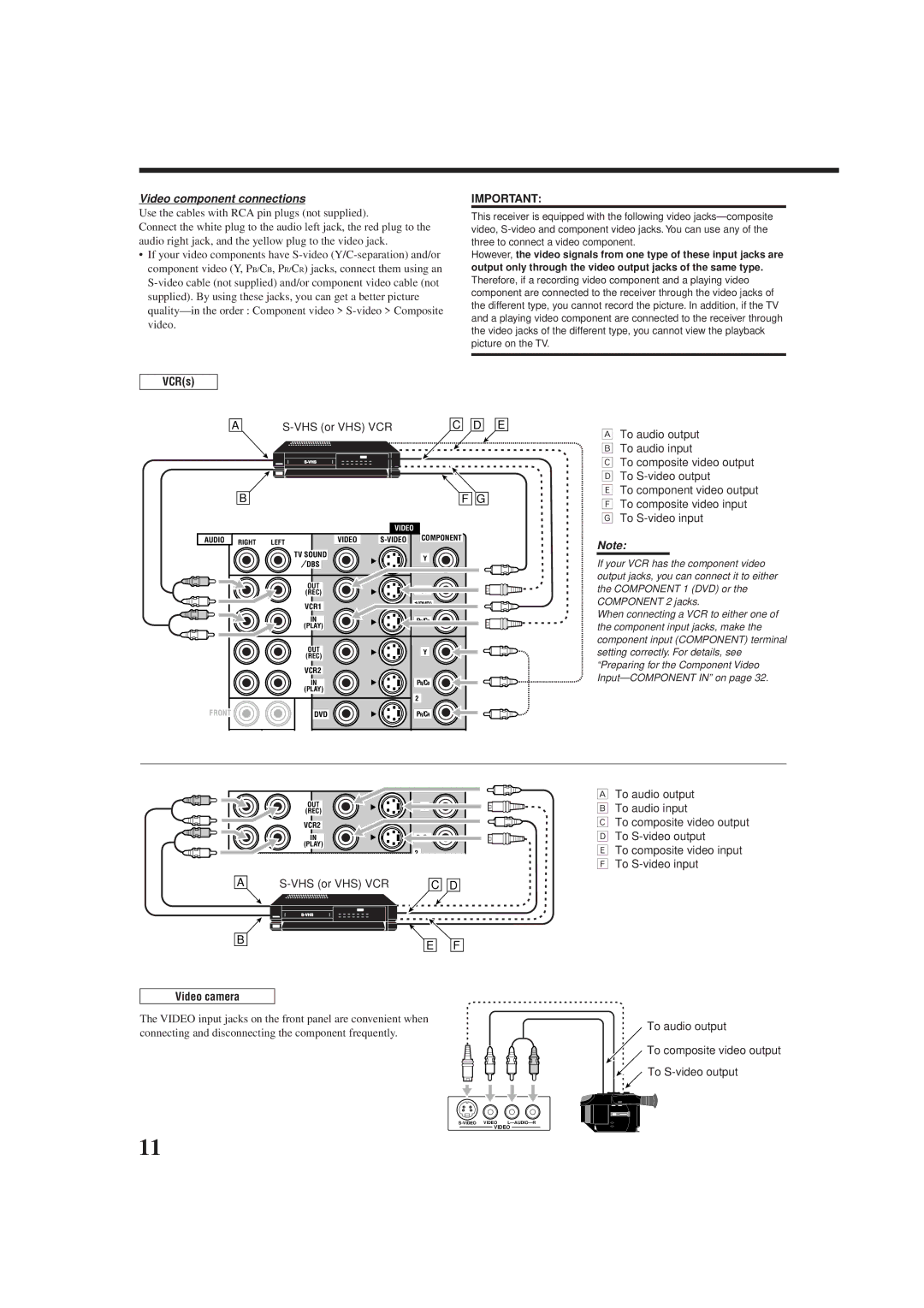RX-DP9VBK
Cautio -- STANDBY/ON switch
21.1 kg / 47 lb
Page
Table of Contents
Introduction
Features
Precautions
Display Window
Parts Identification
Front Panel
For more details, see
Surround/DSP mode indicators
Analog indicator
Digital Auto indicator
Tuned indicator
Lights up when transmitting the remote control signals
Remote Control
Signal transmission indicator
Setup MENU, Adjust MENU, SET, EXIT, %UP DOWN, @LEFT, #RIGHT
Checking the Supplied Accessories
Before Installation
Connecting the FM and AM Antennas
Getting Started
Turn the loop until you have the best reception
Connecting the Speakers
AM Antenna Connections
Speaker layout
Connecting the subwoofer speaker
Basic connecting procedure
Connecting the surround back speakers
Important for the Front 1 Speakers connection
Analog Connections
Connecting Audio/Video Components
Enhance your audio system
Turntable
Cassette deck or MD recorder
CD player
CD recorder
Video camera
VCRs
VHS or VHS VCR
TV and/or DBS tuner
DBS tuner
DVD player
Digital output terminal
Digital Connections
Digital input terminals
Plug the power cord into an AC outlet
Connecting the Power Cord
Putting Batteries in the Remote Control
Replace the cover
Simple Operating Procedure
Basic Operations
Turning the Power On and Off Standby
Selecting the Source to Play
Picture from a video component
Speaker and signal indicators on the display
Front door while viewing
Press one of the source selecting buttons
Adjusting the Volume Activating the Front Speakers
Analog indicator lights up
Selecting the Analog or Digital Input Mode
Select this for the analog input mode
Before you start, remember
Muting the Sound
Attenuating the Input Signal
Turning Line Direct On and Off
Changing the Display Brightness
Making Sounds Natural
Changing the Source Name
When the shut-off time comes
Using the Sleep Timer
Basic adjustment auto memory
To cancel the Sleep Timer
Press FM or AM
Tuning into Stations Manually
Receiving Radio Broadcasts
Press UP or Down inside
Using Preset Tuning
Selecting the FM Reception Mode
Basic Settings
Setup Menu Configuration
Button To do
Operation through On-Screen Display Menus
Menu operation buttons
Press SET
Menu Operating Procedure
Press Setup Menu
Set other items on the same submenu if necessary
For subwoofer
Select this when a subwoofer is connected
Select this when no subwoofer is used
For measuring unit
Setting the Bass Sounds-SUBWOOFER
Preparing for THX Surround Modes-THX
Setting the Dynamic Range -DYNAMIC Range
Setting the Surround Sound Output -SURROUND Speaker
Setting the component video input terminals
Setting the Digital Input Terminals -DIGITAL
Setting the component connected to the digital
Preparing for the Component Video Input -COMPONENT
To recall the volume level
Turning On and Off the Video Output -VIDEO Power
Select this not to store the volume level setting
To cancel the One Touch Operation
Sound Adjustments
Adjustment Menu Configuration
On the front panel
Ex. When you press Adjust Menu
Adjust Menu
When adjusting the parametric equalizer
Press Adjust Menu
Ex.When adjusting a DSP parameter
Adjusting the Speaker Channel Output Levels-LEVEL
Adjusting the Parametric Equalizer -PARAMETRIC EQ
Adjusting the DSP Parameters -DSP Parameter
Adjusting the Center Channel -CENTER Channel
Introducing the Surround Modes
Using the Surround Modes
Reproducing Theater Ambience
THX Surround EX Dolby Digital EX
Dolby Surround Dolby Pro Logic
3D Headphone Mode
DVD Multi Playback Mode
DTS Surround
Activating the Surround Modes
To cancel the THX Surround
To cancel the conventional Surround mode
Select and play one of the following sound sources
Adjusting the Surround Sounds Temporarily
Introducing the DSP Modes
Using the DSP Modes
Reproducing the Sound Field
Activating the DSP Modes
Headphone Mode
Without connecting the surround speakers
If the center speaker is connected and activated
Adjusting the DSP Parameters Temporarily
Ex. When you press DVD Multi
Using the DVD Multi Playback Mode
Activating the DVD Multi Playback Mode
Press DVD Multi so that DVD Multi appears on the display
Press the play 3 button on the CD player
Compu Link Remote Control System
Same time
Displaying the Disc Information on the TV screen
Text Compu Link Remote Control System
CD player MD recorder
Disc Search Only for CD Player
Showing the Disc Information on the TV Screen
Ex. When you press Text Display
Press Text Display while CD or MD is selected as the source
Text display operation buttons
Press %/ Þto move to Performer Then press SET
Press Text Display while CD is selected as the source
Press %/ Þto move to SEARCH, then press
Press SET again
Press %/ Þto move To the genre you Want to search for
Press %/ Þto move to SEARCH, then press SET
Press %/ Þto move To GENRE, then Press SET
On the Search
To insert a space, press
Press Text Display while MD is selected as the source
Press %/ Þto move to the genre you want, then press SET
To correct an incorrect character
Connections 2 Video Cable Connection
AV Compu Link Remote Control System
Connections 1 AV Compu Link Connection
Case
One-Touch Video Play
Automatic Selection of TV’s Input Mode
Automatic Power On/Off
One-Touch DVD Play
Tuner
Operating JVC’s Audio/Video Components
Operating Audio Components
Sound control section Amplifier
Turntable
CD player
CD player-changer
CD recorder
DVD player
Operating Video Components
VCR VCR connected to the VCR 1 jacks
Changing the Preset Signal Codes
Operating Other Manufacturers’ Equipment
Press VCR
Enter manufacturer’s code using
Press and hold VCR
Buttons 1-9,
Press and hold Audio on
If there are more than one code listed for your brand of CD
Press DVD
Press CD
Manufactures codes for Catv converter Manufacturer Codes
Manufactures codes for TV Manufacturer Codes
Manufactures codes for DBS tuner Manufacturer Codes
Manufactures codes for VCR Manufacturer Codes
Troubleshooting
Problem Possible Cause Solution
Audio
Specifications
Amplifier
Video
FM tuner IHF
Tuning Range KHz to 1 710 kHz Usable Sensitivity
Signal-to-Noise Ratio 50 dB 100 mV/m
AM tuner
Authorized Service Centers
Limited Warranty
0701NHMMDWJEIN

